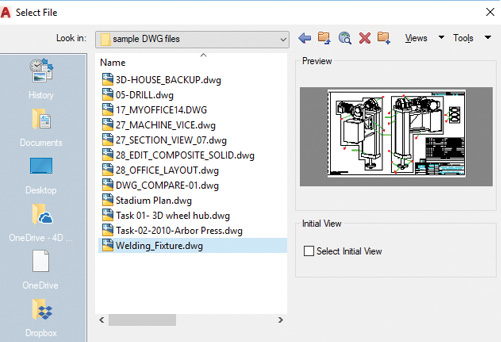
Cloud-based storage solutions now appear in the Places list in file dialogs if you have installed their respective desktop app. Images courtesy of David Cohn.
Latest News
July 1, 2019
Autodesk’s AutoCAD 2020 is the 34th major release of its flagship CAD software. Users were able to download the latest version on March 27, as well as the seven specialized toolsets—AutoCAD Architecture, AutoCAD Electrical, AutoCAD Map 3D, AutoCAD Mechanical, AutoCAD MEP, AutoCAD Plant 3D and AutoCAD Raster Design—starting that same day. Although you must separately download each of the additional toolsets, they are all available as part of a single annual AutoCAD subscription.
Beginning last year, an AutoCAD 2020 subscription now includes free access to the AutoCAD Web and AutoCAD Mobile apps. You can use the Save to Web and Mobile command to save drawings to Autodesk’s A360 cloud-based service, open them in the field using a browser or a mobile device and save any changes back to the cloud. Then, when you get back to the office, you can use the Open from Web and Mobile command to reopen the cloud-based version of the drawing in your desktop version of AutoCAD.

Additionally, external references are now included when you save drawings for web and mobile access. For those companies that require drawings to remain within their organization’s network, AutoCAD’s CAD Manager Control Utility now includes the ability to disable the Save to Web and Mobile and Open from Web and Mobile commands.
New in AutoCAD 2020, however, is the ability to also work with other cloud-based storage solutions, such as Box, Dropbox and OneDrive. Depending on what cloud-based storage apps you have installed on your workstation, the Places list in AutoCAD file selection dialog boxes now include those services.
New Look, Better Feel
What most users will likely notice first about AutoCAD 2020 is its new look. The “dark” theme, which is the default when you first start the program, has a more modern-looking blue background that is much easier on the eyes. Icons stand out better, and context-sensitive ribbons retain the same consistent look. Of course, you can still switch to the “light” theme, and give the ribbon an off-white background.
Users may also notice that the overall performance of AutoCAD 2020 has been improved. Most users should see marked improvement when saving drawings, with most saves taking less than half a second, compared to 1.5 seconds on average in the previous release. In addition, installing the new release should be up to 50% faster for solid-state drives.
Significantly Improved Block Insertion
Although the new look and faster performance are nice perks, the most dramatic change is a new, incredibly intuitive method for inserting blocks. AutoCAD already had several methods for inserting blocks: the Insert command, Tool Palettes and DesignCenter. AutoCAD 2020 introduces a Blocks palette that replaces the old Insert dialog. This is the most significant change to the way blocks work since Autodesk added the block gallery in the 2015 release.
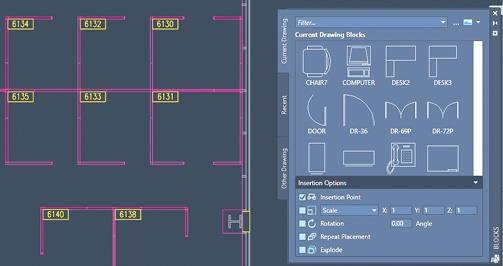
The new Blocks palette makes it extremely simple to select and insert any block at any location, scale or rotation angle regardless of whether the block was defined in the current drawing or in some other drawing.
Now, when you expand the Insert tool in the ribbon, in addition to displaying a gallery of blocks in the current drawing, you can click the Recent Blocks or Blocks from Other Drawings tools to open the Blocks palette.
The Blocks palette has three tabs. The Current tab displays all block definitions in the current drawing. The Recent tab displays the most recently inserted blocks. And the Other Drawing tab provides an easy way to navigate to any folder where you can choose drawings either to insert as blocks or to choose from defined blocks in those drawings. The drawings you select in the Other Drawing tab persist between drawings and sessions.
To insert a block, you simply click it in the palette. The top of the palette also includes controls for applying wildcard filters to block names as well as options for displaying blocks as either different size icons or as a list. Controls in the lower portion of the palette let you control insertion options such as insertion point, scale and rotation angle. If you select Repeat Placement, you can quickly insert multiple instances of the same block. And, since it is a palette, it can be anchored, docked, floated or resized, so that the Blocks palette is readily available whenever you need to insert a block.
More Intuitive Cleanup
The Purge command has also been redesigned for easier drawing cleanup. Although the options remain nearly the same as before, the appearance and organization of the Purge dialog are all new and provide much better feedback. For example, you can now view purgeable and non-purgeable items, with a resizable preview area. Checkboxes provide a better way to select purgeable items by category as well as individual items. You can also now purge zero-length geometry without also purging empty text objects.
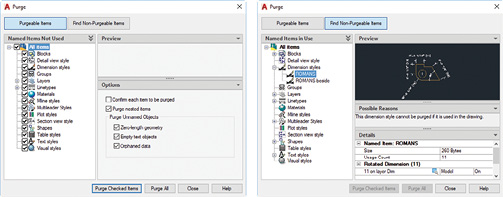
But the biggest change is the ability to display non-purgeable items with a single click. You can then see explanations for why items cannot be purged, how many times a non-purgeable item has been used, what layers those items are on and their effect on file size.
In addition, with a non-purgeable item selected, you can click a Select Objects button to quickly zoom to those objects, which are also selected in the drawing so that you can easily make changes. For example, you could change the properties of the selected non-purgeable objects to move them to a different layer so that you could then purge the original layer.
Better Comparisons
The DWG Compare feature has also been enhanced. Now, you can easily compare the current drawing to another specified drawing and import desired changes into the current drawing at any time. Any changes you make in either the current drawing or the compared drawing are dynamically compared in real time.
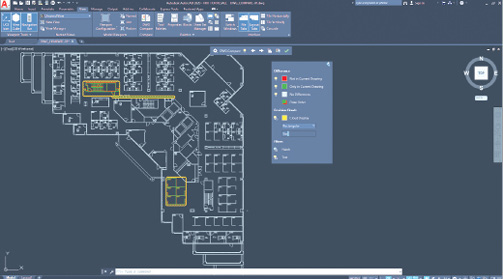
Although most of the comparison options remain the same, instead of a ribbon, the DWG Compare tool now appears on a docked toolbar at the top of the drawing area. Most options have been combined into a Settings control panel that can be pinned open and relocated on screen, so you can easily change the default comparison colors, toggle the comparison categories on and off, swap the order of drawings and adjust revision clouds.
You can also now export both drawings into a new “snapshot drawing” that combines the similarities and changes between both drawings. This operation provides the same result as performing a drawing comparison in AutoCAD 2019.
New Measure Tool and Other Improvements
AutoCAD 2020’s measure tools include a Quick mode, which is active by default. Now, when you click the Measure tool in the ribbon, dimensions, distances and angles are dynamically displayed as you move your mouse over and between objects in a drawing. The cursor displays all nearby measurements, inside and outside the nearest geometry. Of course, the other command options are still available for explicitly measuring distance, radius, angle, area and volume.
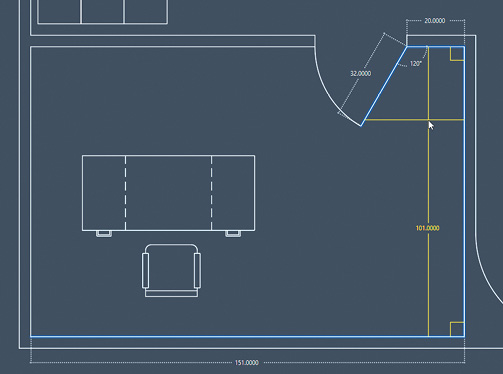
AutoCAD also now correctly launches with different DirectX drivers, high-resolution (4K) displays and dual monitors. And the graphics display settings have been consolidated into three modes, which include gradient hatches and images.
In addition, all of the new tools and enhancements—including the Blocks palette, improved Purge and DWG Compare commands, Quick measure mode, and improved performance—are available in AutoCAD LT 2020 as well. You can download a 30-day free trial of either AutoCAD 2020 or AutoCAD LT 2020 from the Autodesk website.
Although AutoCAD 2020 may not bring the quantity of improvements we have come to expect, the quality of its enhancements should benefit all users, regardless of what they create.
More Autodesk Coverage
Subscribe to our FREE magazine, FREE email newsletters or both!
Latest News
About the Author
David Cohn is a consultant and technical writer based in Bellingham, WA, and has been benchmarking PCs since 1984. He is a Contributing Editor to Digital Engineering, the former senior content manager at 4D Technologies, and the author of more than a dozen books. Email at [email protected] or visit his website at www.dscohn.com.
Follow DERelated Topics







